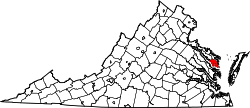Mollusk, Virginia | |
|---|---|
| Coordinates: 37°43′49″N76°32′17″W / 37.73028°N 76.53806°W | |
| Country | United States |
| State | Virginia |
| County | Lancaster |
| Time zone | UTC−5 (Eastern (EST)) |
| • Summer (DST) | UTC−4 (EDT) |
| ZIP codes | 22517 |
| Area code | 804 |
Mollusk is an unincorporated community in Lancaster County in the U. S. state of Virginia. [1]


